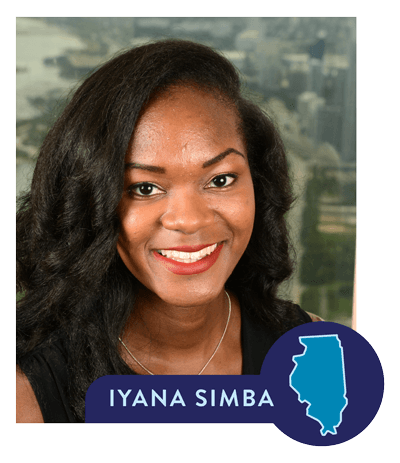Lessons from the Network: Iyana Simba
 Iyana is City Programs Director for Illinois Environmental Council. IEC’s mission is to “advance public policies that create healthy environments across Illinois.” Since IEC’s founding in 1975, the organization has led issue advocacy campaigns by bringing environmental organizations together to pool their resources and create a higher profile for environmental issues.
Iyana is City Programs Director for Illinois Environmental Council. IEC’s mission is to “advance public policies that create healthy environments across Illinois.” Since IEC’s founding in 1975, the organization has led issue advocacy campaigns by bringing environmental organizations together to pool their resources and create a higher profile for environmental issues.
This interview was conducted on July 15, 2021. It has been lightly edited for clarity.
River Network (RN): To get started, can you give me a brief introduction to who you are, your role at Illinois Environmental Council, and how you first got involved with drinking water issues?
Iyana Simba (IS): I’m Iyana Simba, I’m IEC’s Clean Water Policy Director [at the time of this interview; Iyana now serves as the City Programs Director] and really what that means is that I oversee IEC’s coalition building, policy direction, community engagement, research, and pretty much anything related to water issues in Illinois. I especially work on coalition building and policy drafting and then just general advocacy and education. So, one, educating lawmakers on water issues and then also educating the public and trying to raise the public pressure on elected officials. That’s what I do at IEC. How did I first get involved in water issues? I guess, personally, a long time ago, when I was 12, my dad and I did a river clean up in Lansing, and we just found a bunch of really, really messed up stuff like bikes, TVs, all kinds of bad things—and so it made me start thinking more and more about water. So that happened, I went to high school, went to college and then I started interning at IEC, and there was a grant opportunity from the Mott Foundation for a water position. That came up, so that’s how I ended up doing what I’m doing now. That’s how I ended up getting involved in water issues.
RN: There are many facets related to clean drinking water, including issues of access, quality, affordability, and safety. Where do you focus your work? Do you primarily work at the local (city/county), state, regional or federal level?
IS: I think we pretty much cover them all, but I cover, when it comes to water access, I do a lot of work on affordable drinking water, with water systems and affordability, but then also having access to clean water, so that comes more into lead pipes, lead in drinking water, and then also PFAS contamination in water. And then as far as safety and quality—we have our conservation team, as well as our agriculture team that focuses more on the impact of agriculture on water or the impact of having green infrastructure on water, and in general, water quality stuff that has more to do with the land adjacent to it. That work covers local, state, and regional, and now we are doing federal work. For water that mostly looks like ARPA, American Rescue Jobs Plan, seeing how much has been outlined for water, how we can advocate for federal funding. But a lot of our work is at the state and local level, a little bit at the regional level, working with the Ohio Environmental Council, Freshwater Future, other folks in environmental councils trying to work with them and trying to figure out what other states are doing, what else is happening around clean water that we can all focus on.
RN: Access to clean drinking water intersects with public health, environmental justice, climate resiliency, and other issues tied to our health and well-being, like housing. How does your work fit into these broader systems?
IS: I think one, public health, just generally having access to clean affordable water is essential. And I think even tying it more to public health and environmental justice, we think about environmental justice communities as low-income, predominantly black and brown communities, either folks who already have crumbling water infrastructure, but are also not able to afford fixing their water infrastructure, or there’s a lack of technical capacity to access some grants or low interest loan programs that will help them improve their water infrastructure. All to say, at the same time, these are the same communities that have already been impacted by poor water quality. You may have homes, you may have communities that already have deteriorating or older homes that already have lead paint or other lead things within the home, then, on top of that you’re also talking about nearby industry. Not only lead but other chemicals that are in the air, and then in these older homes we also see the issue of flooding. In the context of climate change as we’re seeing these increasing events, thinking about how combined sewer overflows can impact water quality.
From the environmental justice perspective, it’s really just looking at how it’s the same communities that are being doubled impacted, by water issues, but then also cumulative environmental issues and then also not having the capacity to really afford to improve those things. Or the affordability options that have been given to them, they don’t really have the capacity to do those. That’s my perspective, we take, just looking at water issues from an environmental justice perspective, a public health perspective, and also tied into how we think about water affordability issues. When people don’t have access to water, that leaves them at risk for a lot of reasons, not only health-wise, but also just think about the social and economic impact, I mean you could be forced to take out a loan to pay for water, you could be forced to prioritize other utilities, people could actually have their homes condemned and no longer have their children. There’s a lot of different impacts to take into consideration when talking about water.
RN: Illinois Environmental Council worked to pass House Bill 3739, the Lead Service Line Replacement and Notification Act in Illinois (the bill requires water utilities statewide to replace all lead service lines, and goes into effect January 2022). What was the impetus to develop and implement this policy?
IS: A lot of it comes from the tipping point with the Flint Water Crisis that happened. Even prior to that, there were definitely issues with lead in drinking water. Illinois has 1/8 of all lead service lines within the United States, and Chicago being the third largest city, but also having the most amount of lead service lines of any city (maybe don’t quote me on that). The total number of lead service lines is over 400,000 [in the city], that’s kind of what, along with the Flint Water Crisis, is what push ed this whole drive to get rid of lead service lines. That’s where the impetus came from. Over the past couple of years, we’ve worked to pass a law that requires lead testing in daycare and home childcare facilities. We also passed a bill that requires testing in schools, and so this bill was kind of like the last step. We need all municipalities to come up with a plan for lead service line replacement. There’s been several different smaller programs around the state, but we recognize that there needs to be a statewide program, and there needs to be state funding, because we can’t keep pushing down the line. Flint was a very unique situation, but anywhere there’s lead, there could be another Flint crisis.
RN: Can you tell me a little bit about how you help to build support for this policy in terms of engaging community members, elected officials, and also, obviously, maybe trying to get buy in from water utilities in the state? I don’t know if that was something that you also engage with, but a little bit about your coalition building would be great.
IS: I think with the public, knowing about the Flint water crisis kind of helped already build some additional support. Continuing to do education, doing town halls, talking about the dangers of lead, trying to pass different legislation, not just lead service lines, but really just honing in on the impact on children. We ended up have a broader coalition because there was concern from other public health advocates.
As far as elected officials, it’s usually about providing education, providing policy expertise, really trying to lean on the communities that have a lot of lead service lines and trying to encourage them to be like, “Hey, this is something that you should be addressing, you should be supporting something that removes lead from our drinking water.” In addition to education and advocacy, leveraging our relationships. IEC covers a range of environmental issues, so it’s definitely not just water. We’ve worked with these folks for the last 45 years, since 1975, se we do a lot of relationship building with elected officials. As far as water management service providers, somewhat in the same thread, we’ve done work with them before, but also just bringing them into the conversation very early on and making sure that whatever we pass, we understand that it is something that has a huge impact on water management and water utilities. Having them involved very early on in the conversation, going through a lot in negotiation, and every time we reintroduce it, bringing the same people into those conversations trying to look at every single angle and trying to reach some type of compromise. That’s how we build support with utilities. With other coalitions, same thing, building relationships, and also leveraging off the fact that many community groups have direct experience with water issues, and to have personal stories connected to lead in drinking water—we were able to leverage that to build momentum for the bill, and bringing those folks into the process, making sure their needs are being addressed. Overall, it’s about bringing everyone to the table that would be affected by lead in drinking water, bringing them in and early on in the process.
RN: During the pandemic, what did that look like? Was it a lot of digital virtual town hall, Zoom meeting kind of things or how did you reach people when you couldn’t meet in person?
IS: Yeah, we continue to do the virtual town halls. As far as communication, just a lot more check ins, a lot more calls, A LOT more emails, and when appropriate, possible, and safe, having some direct conversations with elected officials in-person. But really a lot of it was relying on virtual tools, that’s really what it was, and it was relying on the previous relationships that we had with elected officials which was really important in how we navigated the whole pandemic while also trying to pass something.
RN: Passing a bill or resolution is a big accomplishment, but we know it isn’t the end of the story. HB 3739 was just passed. (The bill requires all water utilities statewide to replace all lead service lines). Looking forward, how are you going to continue to work with affected communities and/or state agencies to make sure the bill will actually be well implemented?
IS: I mean there’s definitely the whole process of implementation and the whole process of rulemaking. We’re already starting conversations internally with our advocacy folks, and then, once getting on board with them, having conversations with water utilities. Part of the bill actually includes an Advisory Board that will oversee some of the planning of the lead service line replacements, as well as the funding for it. The way to continue to support the bill is to stay in contact with people during the rulemaking process, and I think the Advisory Board will be one opportunity where it will literally include water utilities, impacted communities, non-profit organizations, that’s really going to make sure that all of the folks are still in the process. I think continuing to keep fire to the flame or whatever you want to call it, the advisory board’s going to play a huge role in that.
RN: Is the is there a timeline that’s already embedded within [the act] it or is that something that the Advisory Board will come up with in terms of when these lead replacements will start to occur or when it will be accomplished by?
IS: I believe they will come up with an initial inventory and replacement plan by 2023. And then, as far as actual replacement, I want to say 2027, but don’t quote me on that, but they definitely have quite a few years before the actual lead service line replacements. Some places are already doing it, for example Chicago already has its own lead service line replacement program. But as far as the requirements to start digging up the ground, it’s a few years out from now. And as far as the timeline for when all lead service lines have to be replaced, that ranges from anywhere one year to Chicago which has 50 years because it has the most lead service lines, so it’s a tiered timeline for replacement.
RN: What have been the biggest hurdles or challenges facing your organization as you work on drinking water issues?
IS: I think COVID has shifted how we talk about some of the water issues. I mean prior to that, a lot of our focus was on lead, PFAS, and coal tar, on water contamination issues. With COVID, we had to switch it more to affordability and access to water, because there were people that didn’t even have access to water. So, before we can even go into, “Oh, how does coal tar affect wildlife?” We had to start thinking about “Who actually has access to water and is it actually affordable?” It wasn’t a hurdle, but it was a challenge to kind of shift how we talk about drinking water issues.
With climate change, water issues are exacerbated, especially with flooding and stormwater management. There’s still been a sluggish response. And finally, one of the biggest challenges has just been building collective public outcry about water issues. I think Covid actually helped in terms of water access and affordability arguments, but I think generally… People at large, there needs to be more education to build momentum for water policy. I think it’s something that people haven’t thought about, unless it’s an isolated case where something has leaked into something, I don’t think people get it that the water you’re drinking could have contamination issues. It could be happening to you, in Chicago, in your apartment, and you wouldn’t even know.
RN: What are the major campaigns or policy priorities that you’re currently working on? What kind of strategies are you using to advance your goals?
IS: Right now, our biggest focus is on water assistance and affordability. Through the lead bill we have a low-income water assistance program that the state is designing. We also have Chicago’s Utility Billing Relief Program, which is another water assistance program. Lead service line replacement is obviously still a huge policy priority. And generally, using incoming federal dollars from American Rescue Plan, and thinking about how that can apply to water issues and using it appropriately once it’s here. Also, reducing PFAS contamination in water. We passed a bill that phases out PFAS used in firefighting foam. But we still have to have action levels set, a lot of different things still need to happen with PFAS. As far as strategy goes, I can’t speak to every single one, but continuing to make sure that the way the lead and service line replacement is equitable. We’re trying to build up education and we really want to create a statewide water coalition that can build up that public outcry that we’re wanting… even though we had amazing water victories this past session, we still need to continue the urgency in order to do something next year. Because obviously Covid is going to continue to have an impact, years and years and years out, so we will still need funding for water infrastructure and we still need green infrastructure, we still need to address PFAS, so the general theme across the board is continuing to build elected and public awareness of water issues.
RN: What’s your biggest accomplishment to date? What aspect of your work are you most proud of?
IS: My biggest accomplishment to date… it may be the lead service line replacement bill. At least during the time I’ve been at IEC, I’ve been here for three years, and every single year I’ve seen it introduced, tried to pass it, introduced, tried to pass it. To me, it’s an example of a policy victory story, in which it may not happen once, it may not happen the second time, it may not happen the third time, but eventually, you will be able to get something passed. Emphasizing the point of continuing to raise issues does lead to actual policy results. I think that is a huge accomplishment for IEC. And as part of IEC, what I’m proud of, is the way we’re trying to continue to work with community and [environmental justice (EJ)] partners. Over the last couple of years, we have really been trying to have EJ community groups lead, telling us what they need. We are a white-led organization and instead of leading the charge, checking in before making a lot of policy decisions. We are building better accountability structures, so that’s something I’m really proud of, to be implementing that in my water work.







